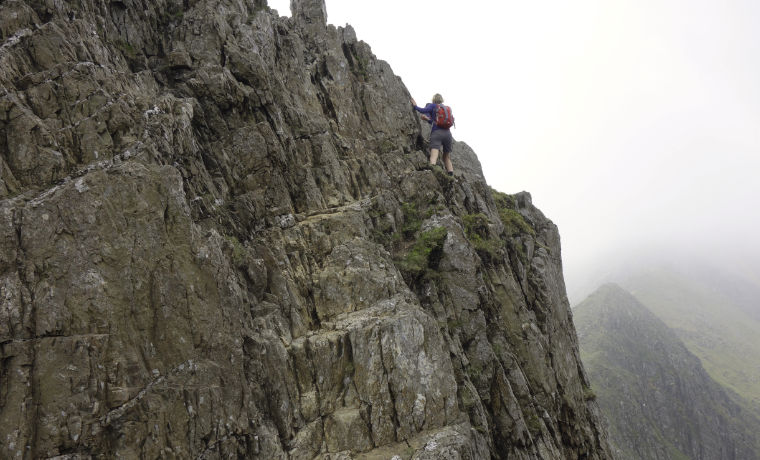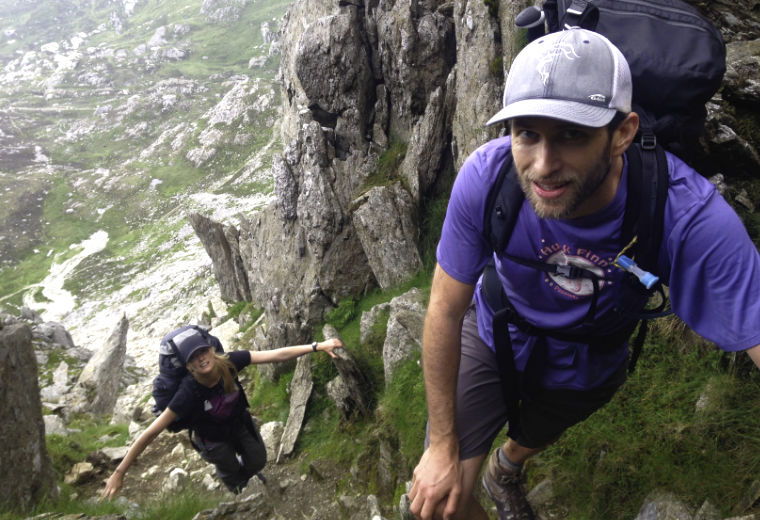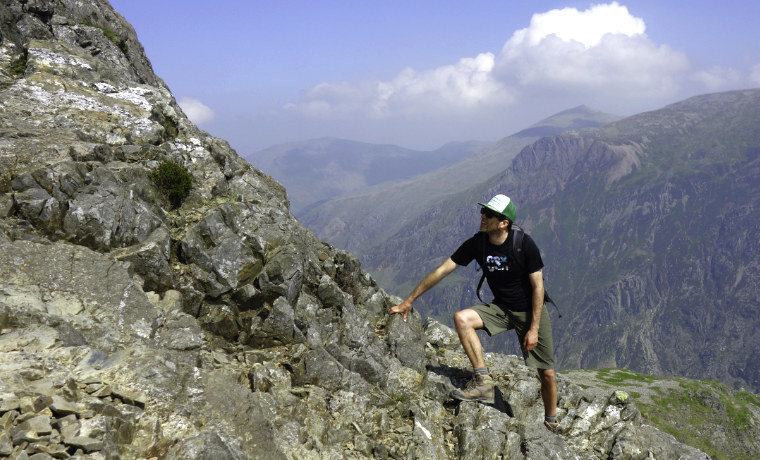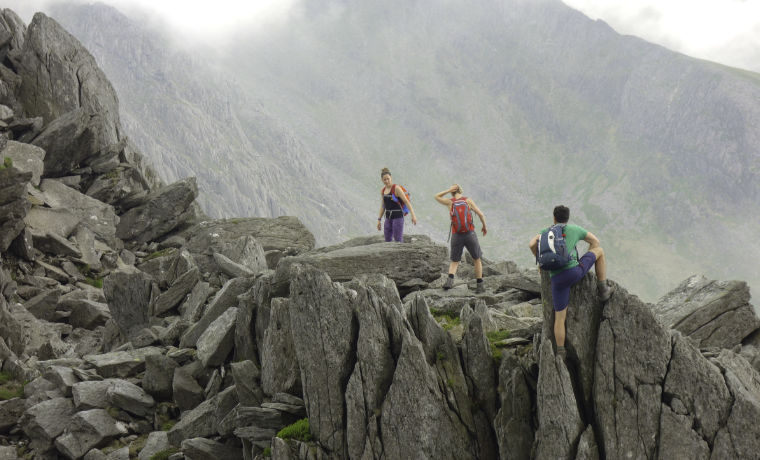Are you a regular hiker looking for a new challenge? Do you want to take on hiking routes that are off the beaten track or even mountainous? Are you feeling adventurous but not quite ready to try your hand at rock or mountain climbing?
Then scrambling is for you!
Scrambling is an excellent addition to your hiking box of skills, and one most hikers can learn relatively easily.
This article explains what scrambling is in hiking and how to do it.
- What is rock scrambling?
- Scrambling grades
- Scrambling equipment
- Learning to scramble
- What is scrambling – summary and conclusion

What is rock scrambling?
Most hikers are already familiar with the term scrambling; it’s arguably the best way to prepare your breakfast eggs after a night in a tent. For that reason, you may see or hear the term “rock scrambling” so you can differentiate.
As this article is about how to rock scramble, be assured that whenever you see the term scrambling, we’re not talking about your morning repast but a bonafide outdoor activity!
The textbook definition of scrambling is somewhat ambiguous. It reads,
a walk up steep terrain often involving the use of one’s hands.
In reality, scrambling is an activity that exists somewhere between hill walking, rock climbing, and easy mountaineering.
Scrambling is the natural transition that occurs when a walker comes to a steep, rocky obstacle and decides to climb up it instead of going around it. Scrambling also involves descents and traverses.
A lot of scrambling routes require no additional equipment or even a change in footwear. However, more demanding scrambles may need safety ropes, and it’s usually a good idea to wear a climbing helmet to avoid injury from falling rocks.

In Italy, where scrambling is very popular, hikers attach themselves to in-situ safety wires and metal ladders, as the routes are often very high and exposed. These routes are called Via Ferrata, which translates as Iron Path.
Some regular hiking trails contain sections of scrambling, and there are also popular routes that involve more scrambling than walking. Canyoning, coasteering, and stream climbing are also activities that feature scrambling.
Scrambling allows you to overcome obstacles that would otherwise bring a hike to an end. Some scrambles follow pre-determined routes or natural rock features, such as gullies and crack systems. In contrast, others simply follow a path of least resistance, and it’s up to the scrambler to find their way. However, unlike hiking trails, scrambling routes are not usually marked.
In the UK, popular scrambling areas include many stretches of the coastline, Snowdonia, the Lakes, and the Scottish Highlands. Elsewhere, there are famous scrambling areas in North America – especially Yosemite, Canada, Italy, Poland, and Slovakia.

Scrambling grades
Despite appearances to the contrary, scrambling is not a completely unregulated activity. In fact, like climbing, routes are graded, so you know how difficult the terrain is likely to be. But, of course, all gradings can be somewhat objective, and what one person finds easy, another may find very challenging.
However, the grades are still a helpful indicator of how hard a scramble is likely to be. The UK scrambling grades, as specified by the British Mountaineering Council (BMC), are:
Grade 1
A grade one scramble is basically an exposed walking trial. They are relatively straightforward and can often be navigated in several ways so you can choose an easier route.
Most grade one scrambles can be attempted without ropes. However, more cautious or nervous participants may prefer to rope up, especially in wet or windy weather. A grade one route requires no specific rock-climbing moves.
Examples of UK grade one scrambles include Striding Edge on Helvellyn, Snowdon’s Crib Goch, and Jack’s Rake on Pavey Ark.
Grade 2
Grade two scrambles start to blur the line between hiking and rock climbing. Ascents are steeper and more exposed, and some climbing is involved. While they can be done without ropes, less competent or confident climbers should rope up for protection.
A grade two scramble is close to the climbing grade of “very difficult” (V Diff). V Diff is the lowest British climbing grade. The Aonach Eagach Ridge in Glen Coe and Wild Boar Clough in the Peak District are Grade two scrambles.
Grade 3
Grade three scrambles are on a par with “moderate” climbing routes. Because of the increased exposure and height, ropes are usually recommended. However, some experienced scramblers may choose to go without.
In addition to being more technically difficult, grade three scrambles often offer no easy retreat or way around the most challenging sections and require greater commitment.
Famous grade three UK scrambles include Pinnacle Ridge in the Lake District, Dolemen Ridge in Snowdonia, and Cuillin Ridge on the Isle of Skye.
Needless to say, if you are new to scrambling, you should cut your teeth on grade one routes. It may also be best to work with a qualified and experienced guide if you want to progress to grade two and grade three scrambling.
Scrambling grades in North America are somewhat different and use the US Yosemite Decimal System (YDS):
-
UK ungraded = YDS 1
- UK Grade 1 = YDS 2
- UK Grade 2 = YDS 3
- UK Grade 3 = YDS 4
Scrambling equipment
Like all outdoor activities, having the right equipment will make your adventure more comfortable and safer, and scrambling is no different. The main things you need to enjoy scrambling are:
- Flexible hiking shoes or boots – grippy Vibram soles are a good option. You don’t need special scrambling shoes, but some people do like to wear climbing shoes on more challenging scrambles. However, climbing shoes are not appropriate for scrambling routes involving a lot of walking; they’re just too darn uncomfortable!
- Stretchy legwear – don’t let tight seams hinder your movements. Hinged knees and elastic materials are best. Shorts may not be a good idea because you could end up with grazed knees.
- Clothing layers – scrambling can be very strenuous, so expect to warm up fast. However, as temperatures usually fall as you get higher, and the weather changes quickly in the mountains, you should also carry warm clothes and waterproofs. You’ll also need to layer up on the less demanding descent.
- Helmet – loose rocks are a common problem when scrambling. Protect your noggin by wearing a helmet, even on easy routes.
- Gloves – scrambling and be tough on your hands, so some participants wear gloves. Wearing gloves will also stop your hands from going numb on colder days but will reduce dexterity. That said, scrambling routes are rarely so difficult that you’ll be using small handholds.
- Rope – a rope will give you confidence on exposed sections, even though the risk of falling is relatively small on most scrambles. However, holds can fail even on an easy route, and a rope could be a literal life saver.Scramblers don’t tend to use full 50m climbing ropes. Instead, they use shorter 30m “half ropes,” which are lighter, easier to manage, and cheaper.
- Food and water – scrambling can be physically tiring, so make sure you are well provisioned for your mountainous adventure. Carry enough water to fend off dehydration and some high-energy snacks to power you up your route. The last thing you need is a hypoglycemic episode part way up a big climb.
- A daypack – for your food, water, first aid kit, helmet, rope, etc. Make sure your pack fits snugly and doesn’t move around as you climb. Nor should it impede your arm movements.

Learning to scramble
Most reasonably fit hikers should be able to successfully complete a grade one scramble. Just move slowly and deliberately and look for the easiest line of ascent.
Alternatively, if you’d prefer to learn from an expert or have aspirations of doing grade two or three scrambles, you could always enrol on a scrambling course. Most outdoor centres offer scrambling lessons.
The main principles of safe and effective scrambling are:
- Choose your route carefully – buy a guidebook or download an online route guide, so you know what to expect on your first scrambling adventure. Forewarned is forearmed! Make sure the route is well within your abilities.
- Test every hand and foothold before committing to it – even strong-looking holds can fail when you use them. Check the solidity of all your holds before putting your weight on them.
- Maintain three points of contact at all times – move one hand or foot to maintain better balance and grip. Leave dangling from one hand for the bouldering gym!
- Try not to use your knees – while it may be tempting, try to use your feet and not your knees. Getting onto your knees is easy, but getting off them is usually much harder than using your feet.
- Avoid over-stretching to reach hand or footholds – it’s usually better to make several small movements than one big one. A high step or long reach can leave you stranded and unable to climb up or down.
- Slow and smooth – even if you feel nervous, make sure you move slowly and smoothly. You are more likely to slip or lose your balance if you hurry.
- Plan your moves in advance – look at the next section you are about to climb and then choose the best (easiest, safest) way to go. Preplanning your moves will help you avoid unexpected difficulties. Remember, it’s almost always easier to go up than down. Downclimbing is trickier because you may not be able to see where you are going.
- Don’t forget to plan your descent – what goes up must come down, and that includes scramblers! It’s usually more enjoyable to descend via a different route than the one you came up on. Make sure you know how you’ll get back down before starting your route. It’s often said that descending is more dangerous than ascending, so pay extra attention to wet and loose rocks and scree to prevent unwanted slips and trips. Remember, too, that you may be tired, and fatigue can lead to mistakes.

What is scrambling – summary and conclusion
For many, scrambling is a natural progression from hiking. Scrambling involves easy climbing over steep terrain. Some hiking routes include sections of scrambling, while there are also routes that involve more scrambling than walking.
You don’t need to be a great climber or have a ton of mountain experience to enjoy scrambling. Thanks to the grading system, you can pick routes that are ideal for beginners and require no ropes or other specialist climbing gear. However, a helmet is always a good idea, and ropes may be needed on more demanding scrambles.
Scrambling is a very natural activity, and the techniques are easy to master, but you will need a head for heights. Some easy scrambles still involve exposed sections, where you are right next to long drops. This means that scrambling is a potentially dangerous activity. Still, most risks can be eliminated with careful planning, appropriate route selection, the right gear, and plenty of common sense.
So, if you want to take hiking to the next level but don’t want to resort to rock climbing or mountaineering, scrambling could be the perfect next step.
The post What Is Scrambling in Hiking? appeared first on Cool of the Wild.


